Great Dane GDRZ25KHE, GDRZ25KAE, GDRZ26KHE User Manual
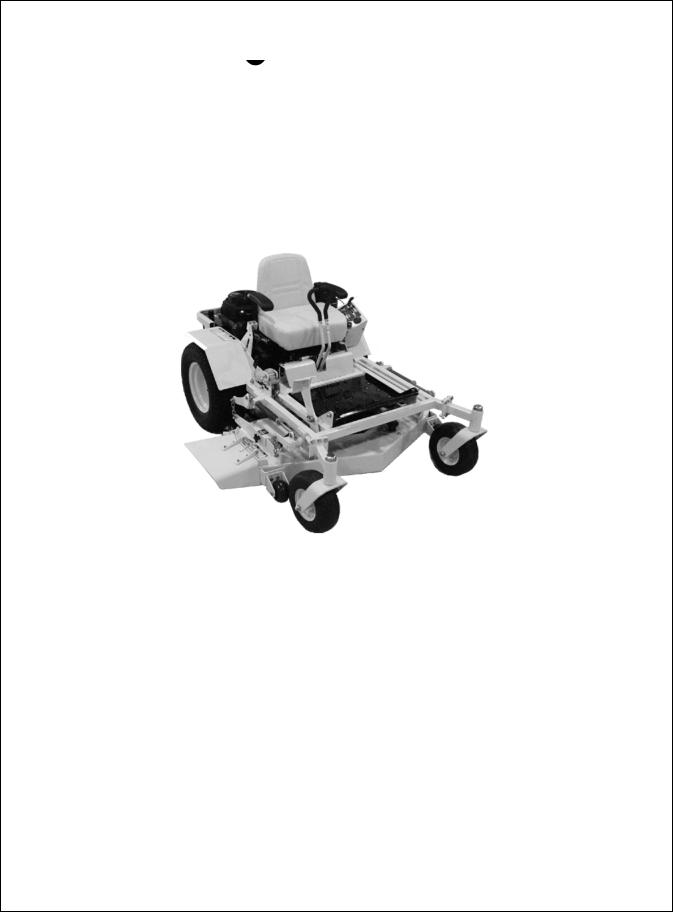
Chariot
GDRZ25KAE, GDRZ25KHE, GDRZ26KHE
OPERATOR’S MANUAL
cWARNING: The Engine Exhaust from this product contains chemicals known to the State of California to cause cancer, birth defects or other reproductive harm.
California Proposition 65 Warning
OMGD10001 B2
D02-105 |
North American Version |
|
Litho in U.S.A.
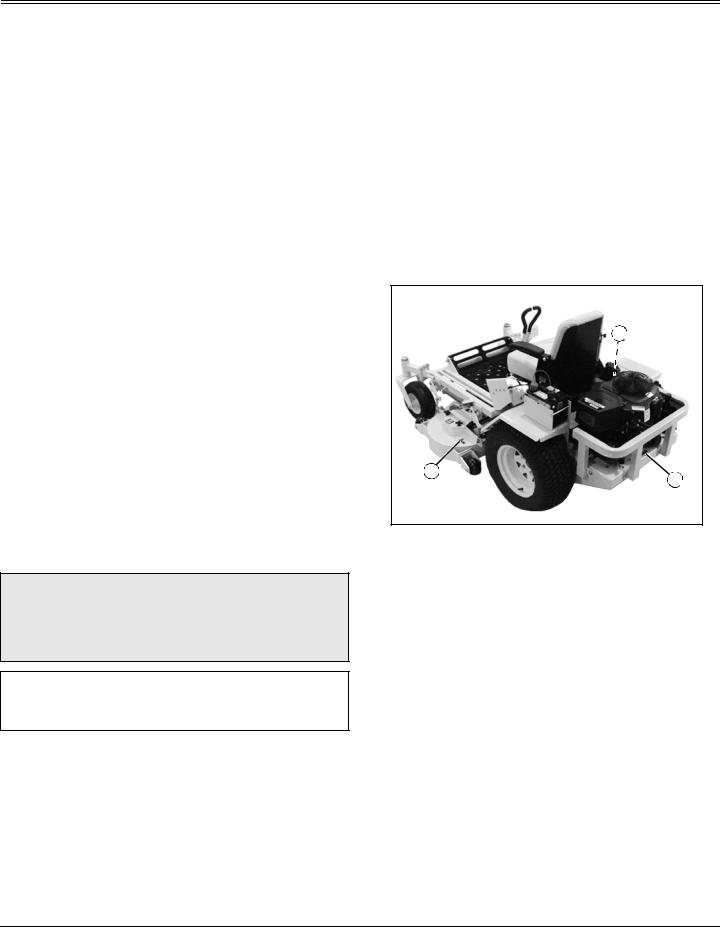
INTRODUCTION
Using Your Operator’s Manual
This manual is an important part of your machine and should remain with the machine when you sell it.
An engine manufacturer’s owner’s manual has been provided with your machine. This will provide maintenance and troubleshooting information for the engine installed in your machine.
Reading your operator’s manual will help you and others avoid personal injury or damage to the machine. Information given in this manual will provide the operator with the safest and most effective use of the machine.
Sections in your operator’s manual are placed in a specific order to help you understand all the safety messages and learn the controls so you can operate this machine safely. You can also use this manual to answer any specific operating or servicing questions.
The machine shown in this manual may differ slightly from your machine, but will be similar enough to help you understand our instructions.
RIGHT-HAND and LEFT-HAND sides are determined by facing in the direction the machine will travel when going forward. When you see a broken line (------), the item referred to is hidden from view.
Special Messages
Your manual contains special messages to bring attention to potential safety concerns, machine damage as well as helpful operating and servicing information. Please read all the information carefully to avoid injury and machine damage.
cCAUTION: Avoid injury! This symbol and text highlight potential hazards or death to the operator or bystanders that may occur if the hazards or procedures are ignored.
IMPORTANT: Avoid damage! This text is used to tell the operator of actions or conditions that might result in damage to the machine.
NOTE: General information is given throughout the manual that may help the operator in the operation or service of the machine.
Record Identification Numbers
Chariot
GDRZ25KAE Serial No. (455000 - 455999)
GDRZ25KHE Serial No. (457000 - 458999)
GDRZ26KHE Serial No. (459000 - 460999)
If you need to contact an Authorized Service Center for information on servicing, always provide the product model and serial numbers.
You will need to locate the model and serial numbers for the machine and for the engine of your machine and record the information in the spaces provided.
DATE OF PURCHASE:
_________________________________________
DEALER NAME:
_________________________________________
DEALER PHONE:
_________________________________________
B
C
A
MX9204
MODEL NUMBER (A):
__ __ __ __ __ __ __ __ __ __ __ __ __ __ __ __ __
SERIAL NUMBER (POWER UNIT) (B):
__ __ __ __ __ __ __ __ __ __ __ __ __ __ __ __ __
ENGINE SERIAL NUMBER (B):
__ __ __ __ __ __ __ __ __ __ __ __ __ __ __ __ __
ENGINE SPECIFICATION NUMBER (C):
__ __ __ __ __ __ __ __ __ __ __ __ __ __ __ __ __
Introduction

|
TABLE OF CONTENTS |
Safety ..................................................................................................................................................................................... |
1 |
Operating................................................................................................................................................................................ |
6 |
Replacement Parts ............................................................................................................................................................... |
10 |
Service Intervals................................................................................................................................................................... |
11 |
Service Lubrication............................................................................................................................................................... |
12 |
Service Engine ..................................................................................................................................................................... |
13 |
Service Transmission............................................................................................................................................................ |
15 |
Service Mower...................................................................................................................................................................... |
18 |
Service Electrical.................................................................................................................................................................. |
23 |
Service Miscellaneous.......................................................................................................................................................... |
26 |
Troubleshooting .................................................................................................................................................................... |
28 |
Storage ................................................................................................................................................................................. |
31 |
Assembly .............................................................................................................................................................................. |
32 |
Specifications ....................................................................................................................................................................... |
34 |
Index ..................................................................................................................................................................................... |
35 |
Service Record GD .............................................................................................................................................................. |
36 |
All information, illustrations and specifications in this manual are based on the latest information at the time of publication. The right is reserved to make changes at any time without notice.
COPYRIGHT© 2002
Deere & Co.
John Deere Worldwide Commercial and
Consumer Equipment Division
All rights reserved
Previous Editions
COPYRIGHT© 2001
OMGD10001 B2 - English
Table of Contents
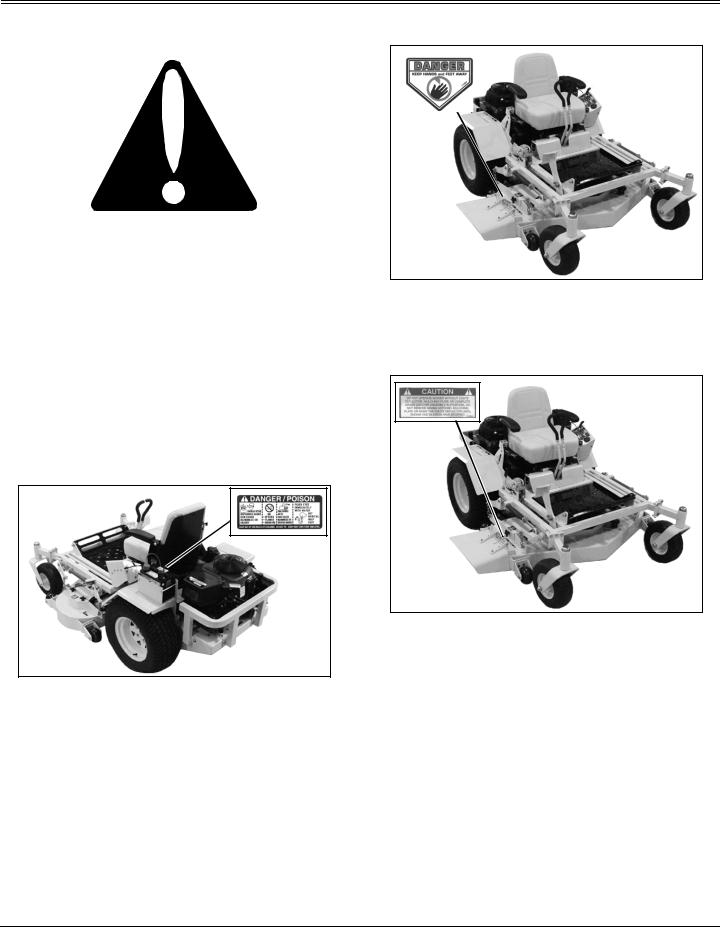
SAFETY
Understanding The Machine Safety Labels |
DANGER |
||
|
|
|
|
|
|
|
|
|
|
|
|
|
|
|
|
MIF
The machine safety labels shown in this section are placed in important areas on your machine to draw attention to potential safety hazards.
On your machine safety labels, the words DANGER, WARNING, and CAUTION are used with this safety-alert symbol. DANGER identifies the most serious hazards.
The operator’s manual also explains any potential safety hazards whenever necessary in special safety messages that are identified with the word, CAUTION, and the safetyalert symbol.
DANGER/POISON
MX9293 MX9214
•Keep hands and feet away.
CAUTION
MX9292 MX9204
•Shield eyes, explosive gases can cause blindness or injury.
•No sparks, flames, smoking.
•Sulfuric acid can cause blindness or severe burns.
•Flush eyes immediately with water, get medical help fast.
•Keep out of the reach of children.
•Do not tip.
•Keep vent caps tight and level.
MX9294 MX9214
•Do not operate mower without chute deflector, mulching plate or complete grass catcher assembly in position.
•Do not remove grass catcher, mulching plate or raise the chute deflector until engine and blade(s) have stopped.
Safety - 1
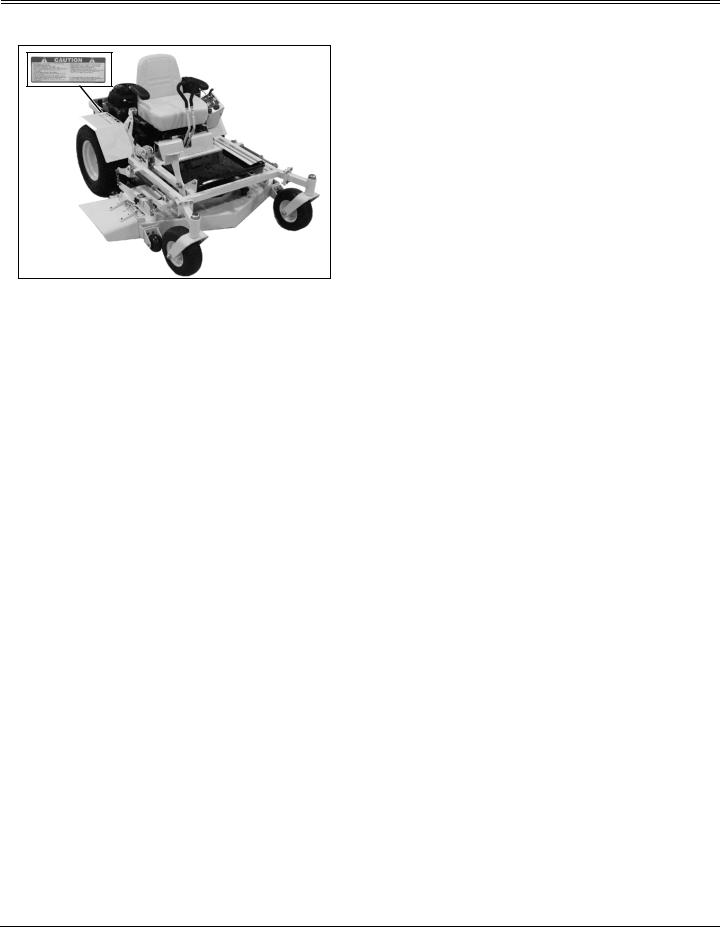
SAFETY
CAUTION
MX9295 MX9214
•This product is designed for professional and commercial users.
•Operation training is required.
•Carefully read safety instructions.
•Know function of controls before operating.
•Practice with cutter blades off until confident.
•Clear mowing area of all debris.
•Keep all guards, covers and shields in place while working.
•Do not disable or bypass any safety device.
•Always wear safety goggles while operating.
•Always park machine on level surface.
•Avoid contact with cutter blades. They may be rotating.
•Keep children and others clear from area.
•Set ground speed control to safe speed.
•Slowly and smoothly move speed control levers to start and stop machine.
•Reduce speed and avoid sharp turns.
•Be careful on slopes, do not mow where stability or traction is in doubt.
•To obtain additional operator manual and safety instructions, contact your Great Dane dealer or write Great Dane Power Equipment, 4700 New Middle Rd., Jeffersonville, IN 47130, USA.
Emission Control System Certification Label
(Small Off-Road Gas Engines)
NOTE: Tampering with emission controls and components by unauthorized personnel may result in severe fines or penalties. Emission controls and
components can only be adjusted by EPA and/or CARB authorized service centers. Contact your Great Dane Equipment Retailer concerning emission controls and component questions.
The presence of an emissions label signifies that the engine has been certified with the United States Environmental Protection Agency (EPA) and/or California Air Resources Board (CARB).
The emissions warranty applies only to those engines marketed by Great Dane that have been certified by the EPA and/or CARB; and used in the United States and Canada in off-road mobile equipment.
Emission Compliance Period (Small Off-Road
Gas Engines)
If your engine has the emission compliance category listed on the emission control system certification or air index label, this indicates the number of operating hours for which the engine has been certified to meet EPA and/or CARB emission requirements. The following table provides the engine compliance period in hours associated with the category found on the certification label.
Agency |
Category |
Hours |
|
|
|
|
|
|
EPA |
C |
250 |
|
|
|
EPA |
B |
500 |
|
|
|
EPA |
A |
1000 |
|
|
|
CARB |
Moderate |
125 |
|
|
|
CARB |
Intermediate |
250 |
|
|
|
CARB |
Extended |
500 |
|
|
|
Operating Safely
•Inspect machine before you operate. Be sure hardware is tight. Repair or replace damaged, badly worn, or missing parts. Be sure guards and shields are in good condition and fastened in place. Make any necessary adjustments before you operate.
•Do not operate mower without discharge chute or entire grass catcher in place.
•Check before each use that operator presence controls are functioning correctly. Test safety systems. Do not operate unless they are functioning correctly.
•Do not change the engine governor setting or overspeed the engine.
•Check brake action before you operate. Adjust or service brakes as necessary.
Safety - 2
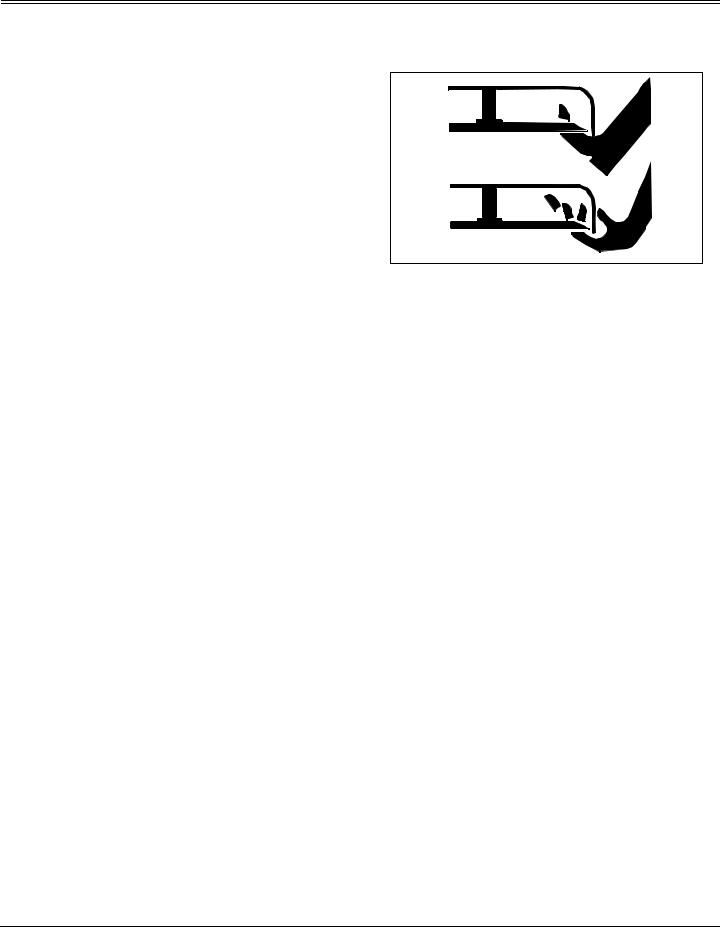
SAFETY
•Stop machine if anyone enters the area.
•Never raise mower decks when blades are running.
•If you hit an object, stop and inspect the machine. Make repairs before you operate. Keep machine and attachments properly maintained and in good working order.
•Do not leave machine unattended when it is running.
•Only operate during daylight or with good artificial light.
•Slow down and be careful of traffic when operating near or crossing roadways. Stop blades before crossing roads or sidewalks. Use care when approaching blind corners, shrubs, trees, or other objects that may obscure vision.
•Be aware of the mower discharge direction and make sure that no one is in the path of the discharge direction.
•Use only accessories and attachments approved by the manufacturer of the machine.
•Wear close fitting clothing and safety equipment appropriate for the job.
•Always wear safety goggles or safety glasses with side shields when operating the mower.
•Wear a suitable protective device such as earplugs. Loud noise can cause impairment or loss of hearing.
•Do not wear radio or music headphones. Safe service and operation requires your full attention.
Checking Mowing Area
•Evaluate the terrain to determine what accessories and attachments are needed to properly and safely perform the job.
•Clear mowing area of objects that might be thrown. Keep people and pets out of mowing area.
•Study mowing area. Set up a safe mowing pattern. Do not mow where traction or stability is doubtful.
•Test drive area with mower lowered but not running. Slow down when you travel over rough ground.
Parking Safely
1.Stop machine on a level surface, not on a slope.
2.Disengage PTO.
3.Lower attachments to the ground.
4.Lock park brake.
5.Stop engine.
6.Remove key.
7.Wait for engine and all moving parts to stop before you leave the operator’s station.
Rotating Blades are Dangerous
HELP PREVENT SERIOUS OR FATAL ACCIDENTS:
MIF
•Rotating blades can cut off arms and legs.
•Keep hands, feet and clothing away from mower deck when engine is running.
•Be alert at all times, drive forward carefully. People, especially children can move quickly into the mowing area before you know it.
•Before backing up, shut off PTO and look down and behind the machine carefully, especially for children.
•Do not mow in reverse.
•Shut off blades when you are not mowing.
•Do not operate machine if you are under the influence of drugs or alcohol.
•Park machine safely before inspecting or unplugging mower or bagger.
PROTECT CHILDREN:
•Never assume that children will remain where you last saw them. Children are attracted to mowing activity, stay alert to the presence of children.
•Keep children indoors when you are mowing. Turn the machine off if a child enters the mowing area.
•Use extra care when you come to blind corners, shrubs, trees, or other objects that may block your vision.
•Do not let children or an untrained person operate the machine.
•Do not carry or let children ride on any attachment or machine even with the blades off. Do not tow children in a cart or trailer.
Avoid Tipping
• Slopes are a major factor related to loss-of-control and tip-over accidents, which can result in severe injury or death.
Safety - 3

SAFETY
•Drive across a hill - not up and down. If necessary, turn slowly and in the downhill direction. Do not shift to neutral and coast downhill.
•Avoid starting and stopping on a slope. If machine stops, disengage mower blades and back down slowly.
•Do not drive where machine could slip or tip.
•Stay alert for holes and other hidden hazards in the terrain.
•Keep away from drop-offs, ditches, and embankments.
•Slow down before you make a sharp turn or operate on a slope. On gear models, choose a low gear so that shifting and stopping will not be necessary while on the slope.
•Transport machine with decks lowered to improve stability.
•Drive machine very slowly and avoid quick stops when attachment is removed.
•Mowing when grass is wet can cause reduced traction and sliding.
Keep Riders Off
•Only allow the operator on the machine. Keep riders off.
•Riders on the machine or attachment may be struck by foreign objects or thrown off the machine causing serious injury.
•Riders obstruct the operator’s view resulting in the machine being operated in an unsafe manner.
Checking Wheel Bolts
•A serious accident could occur causing serious injury if wheel bolts are not tight.
•Check wheel bolt tightness often during the first 100 hours of operation.
•Wheel hardware must be tightened to specified torque using the proper procedure anytime it is loosened.
Driving Safely on Public Roads
Avoid personal injury or death resulting from a collision with another vehicle on public roads:
•Use safety lights and devices. Slow moving machines when driven on public roads are hard to see, especially at night.
•Use extra care when loading or unloading the machine into a trailer or truck.
•Whenever driving on public roads, use flashing warning lights and turn signals according to local regulations. Extra
flashing warning lights may need to be installed.
Practice Safe Maintenance
•Only qualified, trained adults should service this machine.
•Understand service procedure before doing work. Keep area clean and dry.
•Never lubricate, service, or adjust machine while it is moving. Keep safety devices in place and in working condition. Keep hardware tight.
•Keep hands, feet, clothing, jewelry, and long hair away from any moving parts, to prevent them from getting caught.
•Lower attachments to the ground before servicing machine. Disengage all power and stop the engine. Lock park brake and remove the key. Let machine cool.
•Disconnect battery or remove spark plug wire before making any repairs.
•Before servicing machine, carefully release pressure from components with stored energy such as hydraulic components.
•Keep all nuts and bolts tightened, especially blade attachment bolts.
•Securely support any machine elements that must be raised for service work. Lock service latches before working on machine with raised attachments.
•Never run engine unless park brake is locked.
•Keep all parts in good condition and properly installed. Fix damage immediately. Replace worn or broken parts. Replace all worn or damaged safety and instruction decals.
•To prevent fires, remove any buildup of grease, oil, or debris from the machine, especially the engine compartment.
•Charge batteries in an open, well-ventilated area, away from sparks. Unplug battery charger before connecting or disconnecting from the battery. Wear protective clothing and use insulated tools.
•Do not modify machine or safety devices. Unauthorized modifications may impair its function and safety.
•Do not wear radio or music headphones while servicing the machine. Safe service requires your full attention.
Avoid High Pressure Fluids
•Hydraulic hoses and lines can fail due to physical damage, kinks, age, and exposure. Check hoses and lines regularly. Replace damaged hoses and lines.
•Hydraulic fluid connections can loosen due to physical
Safety - 4
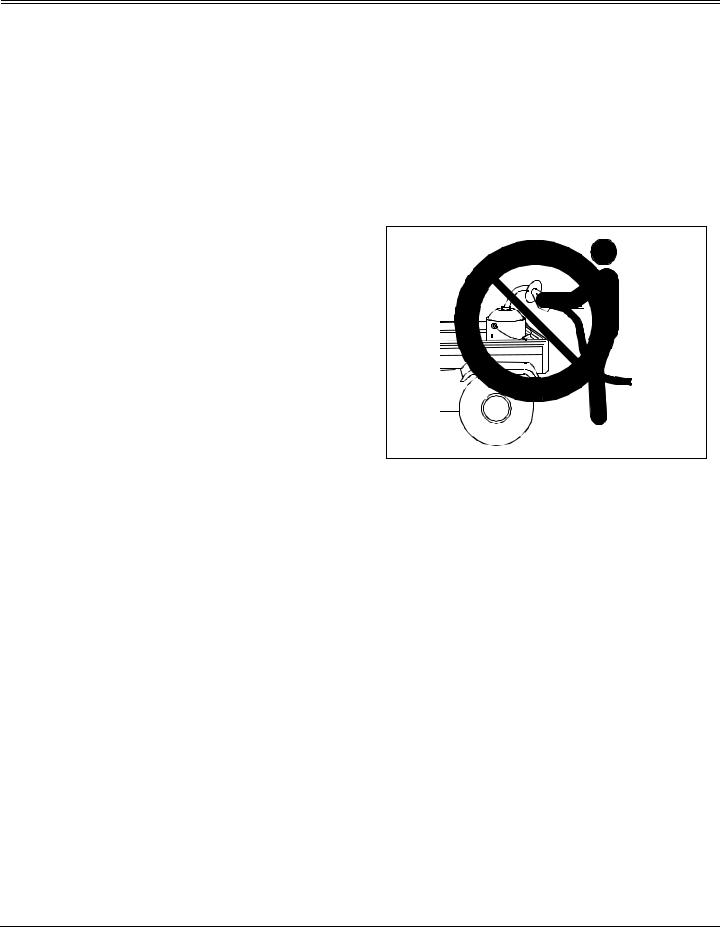
SAFETY
damage and vibration. Check connections regularly. Tighten loose connections.
•Escaping fluid under pressure can penetrate the skin causing serious injury. Avoid the hazard by relieving pressure before disconnecting hydraulic or other lines. Tighten all connections before applying pressure.
•Search for leaks with a piece of cardboard. Protect hands and body from high pressure fluids.
•If an accident occurs, see a doctor immediately. Any fluid injected into the skin must be surgically removed within a few hours or gangrene may result. Doctors unfamiliar with this type of injury should reference a knowledgeable medical source.
running.
•Never fill fuel tank or drain fuel from a machine in an enclosed area. Fill fuel tank outdoors.
•Prevent fires. Clean up spilled fuel immediately.
•Do not store machine with fuel in tank in a building where fumes may reach an open flame or spark.
•Prevent fire and explosion caused by static electric discharge. Use only non-metal, portable fuel containers approved by the Underwriter’s Laboratory (U.L.) or the American Society for Testing & Materials (ASTM). If using a funnel, make sure it is plastic and has no screen or filter.
Prevent Fires
•Never remove fuel cap, or add fuel with engine running or hot. Allow engine to cool for several minutes.
•Never store equipment with fuel in the tank inside a building where fumes may reach an open flame or spark.
•Allow engine to cool before storing in any enclosure.
•To reduce fire hazard, keep engine free of grass, leaves, or excessive grease.
Tire Safety
Explosive separation of a tire and rim parts can cause serious injury or death:
•Do not attempt to mount a tire without the proper equipment and experience to perform the job.
•Always maintain the correct tire pressure. Do not inflate the tires above the recommended pressure. Never weld or heat a wheel and tire assembly. The heat can cause an increase in air pressure resulting in a tire explosion. Welding can structurally weaken or deform the wheel.
•When inflating tires, use a clip-on chuck and extension hose long enough to allow you to stand to one side and not in front of or over the tire assembly.
•Check tires for low pressure, cuts, bubbles, damaged rims or missing lug bolts and nuts.
Handling Fuel Safely
Fuel and fuel vapors are highly flammable and explosive:
•Do not refuel machine while you smoke, when machine is near an open flame or sparks, or when engine is running. Stop engine and allow to cool before filling.
•Never remove the fuel cap or add fuel with the engine
MIF
•Static electric discharge can ignite gasoline vapors in an ungrounded fuel container. Remove the fuel container from the bed of a vehicle or the trunk of a car and place on the ground away from the vehicle before filling. Keep nozzle in contact with container opening while filling.
•When practical, remove equipment from trailers or truck beds and refuel them on the ground. If this is not possible, use a portable, plastic fuel container to refuel equipment on a truck bed or trailer.
•For gasoline engines, do not use gas with methanol. Methanol is harmful to your health and to the environment.
Safety - 5
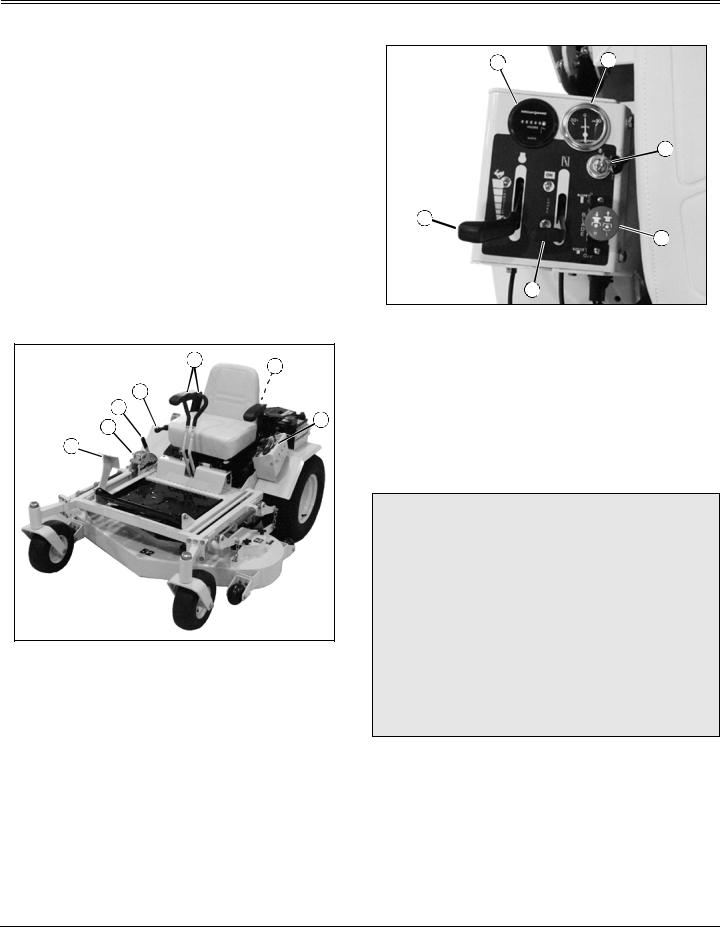
OPERATING
Daily Operating Checklist
Test safety systems.
Check tire pressure.
Check fuel level.
Check engine oil level.
Remove and clean engine air filter.
Check transmission oil reservoir level.
Remove grass and debris from machine.
Clean engine cooling air intake screen and cooling fins.
Inspect all belts for damage.
Sharpen and balance mower blades.
Check area below machine for any fuel or oil leaks.
Operating Controls
F |
E |
|
|
||
A |
|
|
D |
G |
|
B |
||
|
C
MX9206
A- Park Brake Lever
B- Height-of-Cut (HOC) Adjustment Pin
C- Mower Deck Lift/Lower Pedal
D- Mower Deck Transport Position Lock Lever
E- Fuel Shutoff Valve
F- Steering Control Levers
G- Console
Console Controls
E F
F
B
A
D
C
MX9205
A- Throttle Lever
B- Key Switch
C- Choke Lever
D- PTO/Clutch Switch
E- Hourmeter
F- Ammeter
Testing Safety Systems
cCAUTION: Avoid injury! Engine exhaust fumes contain carbon monoxide and can cause serious illness or death.
Move the vehicle to an outside area before running the engine.
Do not run an engine in an enclosed area without adequate ventilation.
•Connect a pipe extension to the engine exhaust pipe to direct the exhaust fumes out of the area.
•Allow fresh outside air into the work area to clear the exhaust fumes out.
Use the following checkout procedure to check for normal operation of machine.
If there is a malfunction during one of these procedures, do not operate machine. See your Great Dane dealer for service.
Perform these tests in a clear open area. Keep bystanders away.
Operating - 6

OPERATING
Testing Park Brake Safety Switch
1.Operator must be seated in the seat (seat safety switch engaged).
2.Move control levers to neutral position.
3.Move PTO/clutch switch to off position.
4.Unlock park brake.
5.Turn key switch to start position.
Result: The engine must not crank.
Testing Park Brake
Stop the machine on a maximum 17° slope. Stop the engine and lock the park brake.
Result: Park brake must hold the machine stationary. If the machine moves more than 61 cm [24 in.] in one hour, brakes need to be adjusted. See your Great Dane dealer.
Testing Neutral Start Safety Switch
1.Operator must be seated in the seat (seat safety switch engaged).
2.Move control levers to forward travel position.
3.Move PTO/clutch switch to off position.
4.Lock park brake.
5.Turn key switch to start position.
Result: The engine must not crank.
Testing Seat Safety Switch
1.Operator must be seated in the seat (seat safety switch engaged).
2.Move control levers to neutral position.
3.Start the engine.
cCAUTION: Avoid injury! Before engaging mower, clear area of bystanders, especially children.
4.Move PTO/clutch switch to on position.
5.Operator rises slightly off the seat.
Result: The engine must stop.
Testing PTO/Clutch Safety Switch
1. Operator must be seated in the seat (seat safety switch engaged).
2.Unlock park brake.
3.Move PTO/clutch switch to on position (mower deck drive engaged).
4.Turn key switch to start position.
Result: The engine must not crank.
Using the Park Brake
Move park brake lever to the raised (locked) position to lock the park brake. This will also engage the park brake safety switch.
Starting the Engine
cCAUTION: Avoid injury! Engine exhaust fumes contain carbon monoxide and can cause serious illness or death.
Move the vehicle to an outside area before running the engine.
Do not run an engine in an enclosed area without adequate ventilation.
•Connect a pipe extension to the engine exhaust pipe to direct the exhaust fumes out of the area.
•Allow fresh outside air into the work area to clear the exhaust fumes out.
1.Open the fuel shutoff valve.
2.Operator must be seated in the seat (seat safety switch engaged).
3.Lock park brake.
4.Move control levers to neutral position.
5.Move PTO/clutch switch to off position.
6.Move throttle lever to half-speed position.
7.Adjust choke as required.
IMPORTANT: Avoid damage! Starter may be damaged if starter is operated for more than 20 seconds at a time:
• Wait 2 minutes before trying again if the engine does not start.
8. Turn key switch to start position for no more than 5 seconds. Release key to the run position when engine starts.
•If the engine does not start, wait 10 seconds.
•Turn key to start position again for no more than 5
Operating - 7

OPERATING
seconds.
•Repeat the procedure if necessary.
IMPORTANT: Avoid damage! Unnecessary engine idling may cause engine damage. Excessive idling can cause engine overheating, carbon build-up and poor performance.
9. Let the engine run at half-speed position for several minutes to warm up before operating the machine. Reduce choke setting as the engine warms up.
Operating the Machine
cCAUTION: Avoid injury! Learn the use of the control levers. Practice at half throttle until becoming proficient and comfortable with the operation of the machine.
Do not move control levers from forward to reverse or reverse to forward position rapidly. Sudden direction changes could cause loss of control or damage the machine.
1.Adjust mower deck to desired cutting height.
2.Start and warm up engine at half throttle.
3.Move PTO/clutch switch to on position.
4.Move throttle lever to wide open position.
5.Unlock park brake.
NOTE: The travel speed and turn rate will vary with the amount that the control levers are moved.
MX9220
6. Drive the machine:
To drive the machine forward: Push both control levers forward smoothly and evenly.
To turn the machine: Pull the control lever back on the same side as the direction of the desired turn. Push the other lever forward.
To stop the machine: Return both control levers to the
neutral position.
To drive the machine in reverse: Pull both control levers back evenly.
Stopping the Machine
NOTE: If the operator leaves the seat without placing the PTO switch in the off position, the mower blades will stop as soon the operator leaves the seat.
1.Move the PTO/clutch switch to the off position.
2.Return both control levers to the neutral position.
cCAUTION: Avoid injury! Children or bystanders may attempt to move or operate an unattended machine.
Always lock the park brake and remove the key before leaving the machine unattended.
3.Lock park brake.
4.Move the throttle lever to the half-speed position, and let the engine run at low throttle for a few seconds.
5.Turn the key switch to the stop position.
6.Remove key.
Adjusting Cutting Height
Cutting height can be adjusted from approximately 25-152 mm (1-6 in.). Each hole adjusts the height of cut (HOC) in 13 mm (1/2 in.) increments.
The deck can also be raised and locked in a transport position to provide maximum ground clearance when moving the machine from one area to another.
A
C
B
MX9215
1.Push the mower deck lift/lower pedal (A) forward to raise and latch the deck in the transport position.
2.Position the HOC adjustment pin (B) in the proper hole for the desired height of cut.
Operating - 8
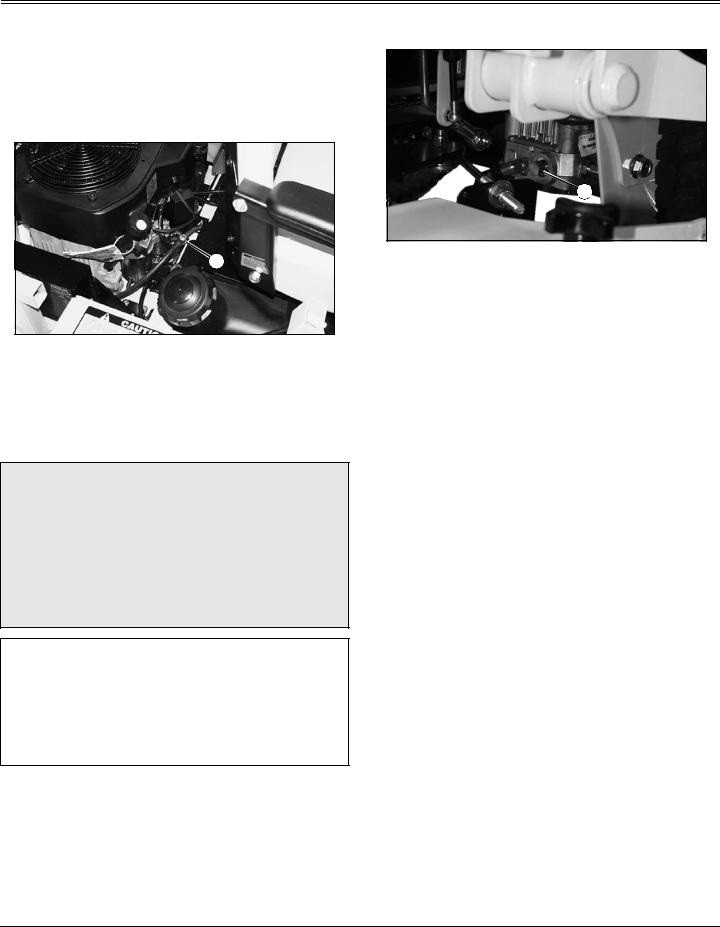
OPERATING
3.Depress and hold the mower deck lift/lower pedal (A) and release the transport position lock lever (C).
4.Release the mower deck lift/lower pedal (A) and allow the pedal to rest against the HOC pin.
Using the Fuel Shutoff Valve
A
MX9409
Move the fuel shutoff valve (A) to the on position for normal operation. Move the valve to the off position when the machine is not in use and during transport.
Moving the Machine Manually
cCAUTION: Avoid injury! With the free-wheeling valve open, the machine will have unrestricted motion.
•The machine may free-wheel out of control if the free-wheeling valve is opened with the machine on an incline.
•Park the machine on a level surface before opening the free-wheeling valve.
IMPORTANT: Avoid damage! Transmission damage may occur if the machine is moved or towed incorrectly:
•Move unit by hand only.
•Do not use another vehicle to move unit.
•Do not tow unit.
1.Park machine safely. (See Parking Safely in the Safety section.)
NOTE: The pumps are located under the machine, behind the mower deck.
A
MX9226
Picture Note: Left pump shown.
2.Turn free-wheeling valves (A) on both pumps one full turn counterclockwise (open position).
3.Unlock park brake.
4.Push machine to desired location. Due to internal hydraulic system resistance, the machine will move slowly.
5.Turn free-wheeling valves (A) on both pumps one full turn clockwise (closed position). Tighten the valves to 9-14 N•m (80-120 lb-in.).
6.Lock park brake.
Operating - 9
